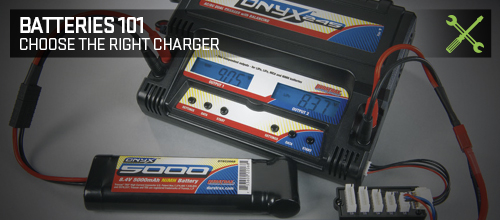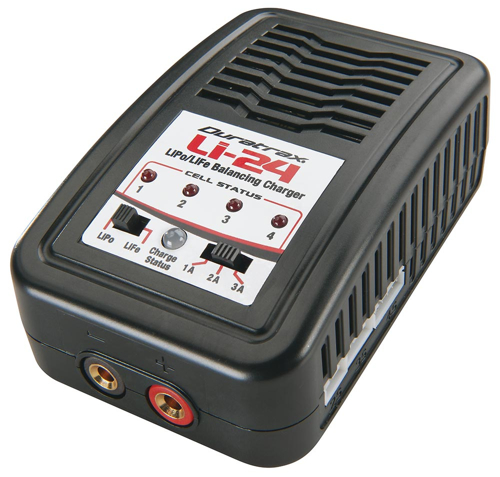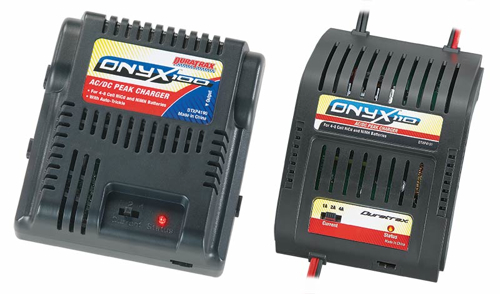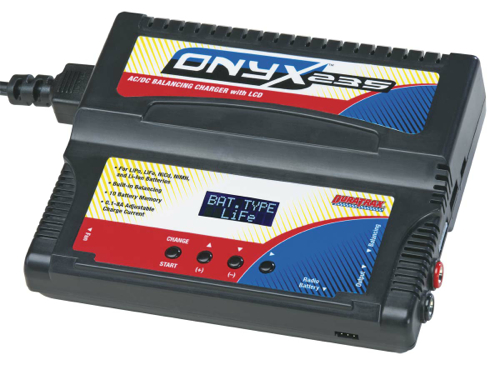Posted: 9/25/14

A charger is one of the most important purchases you can make. As such, picking the right charger takes careful consideration. Price is important, but can't be the only deciding factor.

Chemistry/Compatibility
There are charges that can charge a variety of battery chemestries, but the two most critical for use in RC are LiPo and NiMH. LiPo packs are currently the most popular and high performance technology. NiMH packs are older and heavier technology, but are less expensive. Both chemestries are still widely used, so it is recommended that you select a charger that can charge both chemestries. It is essential that you only use the specific mode for the battery type you wish to charge. A LiPo pack must only be charged in LiPo mode--no exceptions. Also, confirm that the charger uses the CC/CV style of charging for LiPo. CC/CV means the charger charges at a constant current, say 5 amps, until a nearly fully charged voltage level is reached and then switches to maintaining that voltage by fluctuating the current. CC/CV is the only charging method Axial recommends for LiPo packs. Same for NiMH. Even if you don't own any LiPo packs, it is recommended that you purchase a LiPo capatable charger, so that you don't have to purchase another charger when you do upgrade packs. Many people start off with NiMH packs to save money, but spend more money in the long run when they have to purchase a second charger. NiMH chargers do not command a strong resell value. It is also recommended that only a balance charger is used and that the pack (regardless of chemestry) is charged in a charging pouch.

Power Source
Chargers can be powered by either AC (house current), DC (12V battery or outlet) or both (AC/DC). Obviously, the latter is the most versatile, but is often bulkier and more expensive. While there are a few AC-only chargers, most are either DC-only or AC/DC. DC-only chargers can be powered at home via a 12-volt power supply, but that requires a separate purchase and space on your bench or RC work area. The main advantages of DC-only chargers is that they tend to be compact and are less expensive. The specifications of the power supply correlate to the charge rate specifications of the charger (see below).

Screens
Not all chargers have LED screens, but if your budget allows, a screen is highly recommended. The larger the screen the better as it allows for far more clear display of information with fewer cryptic abbreviations for data. Backlit screens aren't essential, but make outdoor viewing especially better. Backlit displays are generally easier to read in all lighting conditions, but if you only plan to use your charger in a darker basement or garage type work area, it is a feature you could live without if need be.
Rates
Charge rate refers to the amperage (amps), a measurement of electrical current, a charger can deliver to a battery. The higher the amps, the less time it takes to charge. You cannot simply charge at the highest rate possible, however. NiMH packs should be charged at 5 amps or less. LiPo packs are recommended to be charged at 1C or 2C and to always be charged in balance mode with the battery in a charging bag/sack for safety. 1C is one times the battery’s capacity, which would equal 5 amps for a common 5000 mAh battery pack, 4 amps for a 4000 mAh pack, 3.2 amps for a 3200 mAh pack, etc. 2C is two times the capacity, and thus, a 10 amp charge rate for a 5000 mAh pack.
Knowing what size batteries you plan to charge most often will make picking the right charger much easier. The key (and sometimes harder information to find) is understanding how much power (watts) a charger’s power supply can deliver. This is especially important if you have an Axial Yeti, EXO Terra Buggy or an SCX10 equipped with the 3S-capable AE-5 speed control and you’re using, or plan to use, 3S LiPo packs, which are 11.1 volt packs and require significantly more power from a charger’s power supply to charge at the same rate used for a 2S (7.4V) pack. If a charger doesn’t have enough power (watts) it won’t be able to charge at the amperage level you want. This really isn’t a significant concern if you’re charging a few LiPo packs for a day’s worth of rock crawling, but if you are rock racing your Yeti and need to charge a 3S pack between rounds, it can be critical. If you have a charger with a 50W built-in power supply, it won’t be able to charge a 3S 5000 mAh LiPo pack at 5 amps. To calculate how many watts are needed, multiply the charge rate by the pack’s voltage. In the 3S 5000 mAh example, the equation is 5 amps multiplied by 11.1V for a wattage requirement of 55.5 watts (5x11.1=55.5). Technically, 11.1 is the nominal voltage and 12.6 is the fully charged voltage, so if 12.6 is used, the maximum wattage requirement is 63 watts.